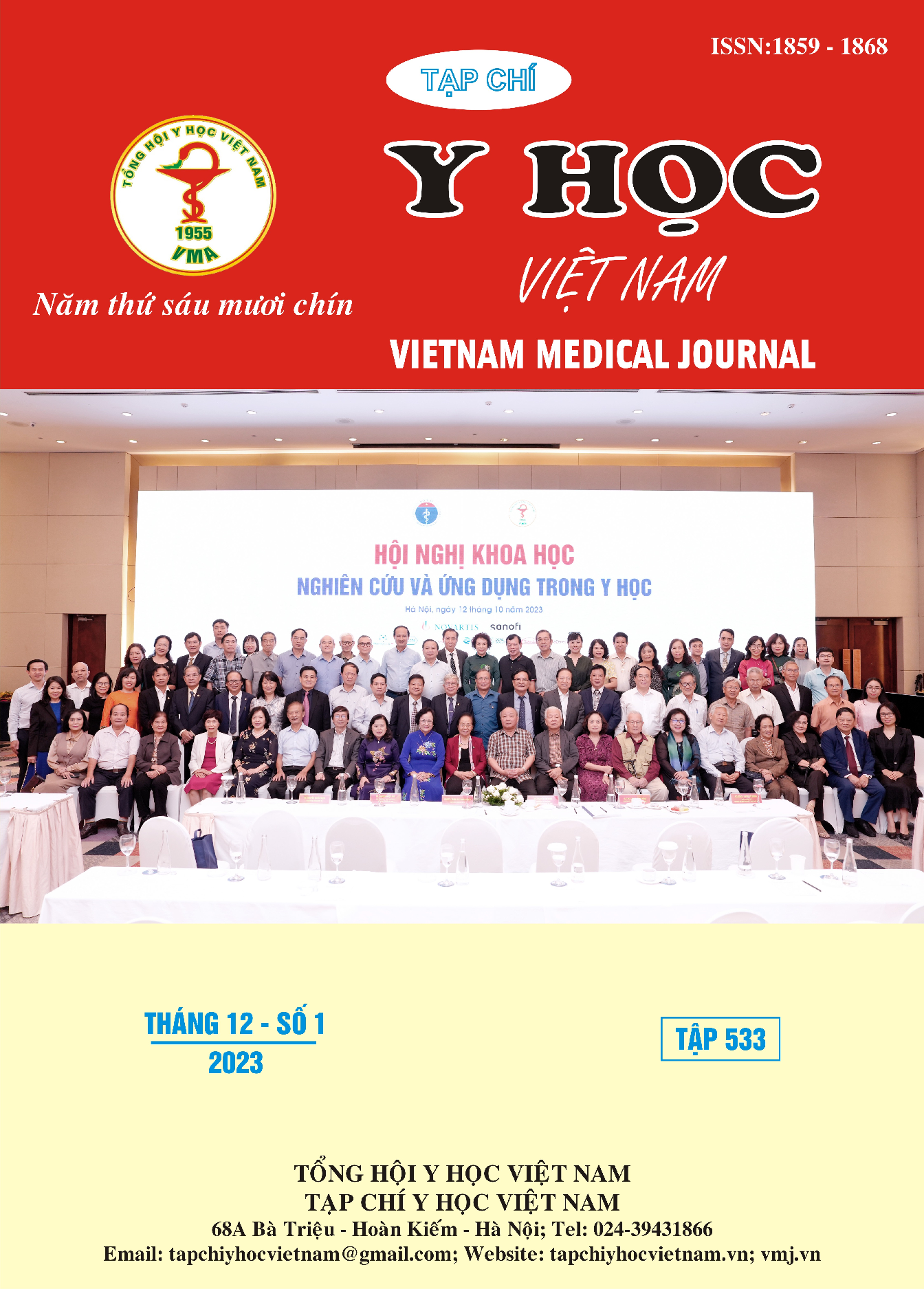KẾT QUẢ ĐIỀU TRỊ U LYMPHO KHÔNG HODGKIN VÙNG RÌA BIỂU HIỆN TẠI HỐC MẮT
Nội dung chính của bài viết
Tóm tắt
Mục tiêu: Đánh giá kết quả điều trị bước đầu u lympho không Hodgkin vùng rìa biểu hiện tại hốc mắt. Đối tượng và phương pháp nghiên cứu: Nghiên cứu mô tả chùm ca bệnh trên 56 bệnh nhân u lympho không Hodgkin vùng rìa biểu hiện tại hốc mắt được chẩn đoán và điều trị tại bệnh viện K từ tháng 3/2019 đến tháng 6/2023. Kết quả nghiên cứu: Nghiên cứu thực hiện trên 56 bệnh nhân. Tuổi trung bình của bệnh nhân là 59,2 ± 12,8; tỉ lệ nam/nữ là 2,3/1. Sờ thấy u là triệu chứng cơ năng thường gặp nhất (21,4%). Khoảng 1/4 bệnh nhân có tổn thương ngoài hốc mắt, chủ yếu là hệ thống hạch (66,6%) và 87,5% bệnh nhân ở giai đoạn I, II. Tỉ lệ đạt bệnh ổn định với các bệnh nhân có chỉ định theo dõi không điều trị do không có triệu chứng lâm sàng sau 12 tháng là 83,3%. Với các bệnh nhân có chỉ định điều trị, tỉ lệ đáp ứng hoàn toàn sau điều trị là 40,6%, trong đó hóa trị kết hợp Rituximab là 52,4%, với Rituximab đơn trị là 50%, với tia xạ là 0%. Phác đồ R-bendamustin được sử dụng nhiều nhất và đạt được đáp ứng hoàn toàn tốt nhất (60%). Kết luận: Theo dõi không điều trị mang lại hiệu quả cao. Tỉ lệ đáp ứng với các bệnh nhân có chỉ định điều trị khá tích cực, trong đó hóa trị kết hợp điều trị đích có hiệu quả lớn nhất, đặc biệt là phác đồ R-bendamustin. Điều trị đích hoặc tia xạ cũng là một phương pháp điều trị khả quan với giai đoạn I.
Chi tiết bài viết
Từ khóa
U lympho vùng rìa, u lympho tại hốc mắt, điều trị
Tài liệu tham khảo
2. McKelvie PA, McNab A, Francis IC, Fox R, O’Day J. Ocular adnexal lymphoproliferative disease: a series of 73 cases. Clin Experiment Ophthalmol. 2001;29(6): 387-393. doi: 10.1046/ j.1442-9071.2001.d01-18.x
3. Coupland SE, Krause L, Delecluse HJ, et al. Lymphoproliferative lesions of the ocular adnexa: Analysis of 112 cases. Ophthalmology. 1998; 105(8): 1430-1441. doi: 10.1016/S0161-6420(98)98024-1
4. Nakata M, Matsuno Y, Katsumata N, et al. Histology according to the Revised European-American Lymphoma Classification significantly predicts the prognosis of ocular adnexal lymphoma. Leuk Lymphoma. 1999;32(5-6):533-543. doi:10.3109/10428199909058411
5. Jenkins C, Rose G, Bunce C, et al. Histological features of ocular adnexal lymphoma (REAL classification) and their association with patient morbidity and survival. Br J Ophthalmol. 2000;84(8):907-913. doi:10.1136/bjo.84.8.907
6. Harris N, Jaffe E, Stein H, et al. A revised European-American classification of lymphoid neoplasms: a proposal from the International Lymphoma Study Group [see comments]. Blood. 1994;84(5): 1361-1392. doi: 10.1182/ blood. V84.5.1361.1361
7. Harris NL, Jaffe ES, Diebold J, et al. The World Health Organization classification of neoplastic diseases of the hematopoietic and lymphoid tissues. Report of the Clinical Advisory Committee meeting, Airlie House, Virginia, November, 1997. Ann Oncol Off J Eur Soc Med Oncol. 1999;10(12): 1419-1432. doi: 10.1023/ a:1008375931236
8. Tanimoto K, Kaneko A, Suzuki S, et al. Long-term follow-up results of no initial therapy for ocular adnexal MALT lymphoma. Ann Oncol Off J Eur Soc Med Oncol. 2006;17(1): 135-140. doi: 10.1093/annonc/mdj025
9. Zucca E, Conconi A, Laszlo D, et al. Addition of rituximab to chlorambucil produces superior event-free survival in the treatment of patients with extranodal marginal-zone B-cell lymphoma: 5-year analysis of the IELSG-19 Randomized Study. J Clin Oncol Off J Am Soc Clin Oncol. 2013; 31(5): 565-572. doi: 10.1200/ JCO.2011. 40.6272
10. Zucca E, Conconi A, Martinelli G, et al. Final Results of the IELSG-19 Randomized Trial of Mucosa-Associated Lymphoid Tissue Lymphoma: Improved Event-Free and Progression-Free Survival With Rituximab Plus Chlorambucil Versus Either Chlorambucil or Rituximab Monotherapy. J Clin Oncol Off J Am Soc Clin Oncol. 2017;35(17): 1905-1912. doi:10.1200/JCO.2016.70.6994


